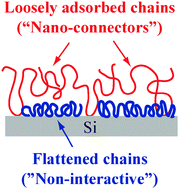Nanoscale adsorbed structures as a robust approach for tailoring polymer film stability†
Abstract
The stability or wettability of thin polymer films on solids is of vital interest in traditional technologies as well as in new emerging nanotechnologies. We report here that nanoscale structures of polymer chains adsorbed onto a solid surface play a crucial role in the thermal stability of the film. In this study, polystyrene (PS) spin-cast films (20 nm in thickness) with eight different molecular weights prepared on silicon (Si) substrates were used as a model. When low molecular weight (Mw ≤ 50 kDa) PS films were subjected to thermal annealing at temperatures far above the bulk glass transition temperature, dewetting occurred promptly, while high molecular weight (Mw ≥ 123 kDa) PS films were stable for at least 6 weeks at 150 °C. We reveal a strong correlation between the film stability and the two different interfacial structures of the adsorbed polymer chains: their opposing wettability against chemically identical free polymer chains results in a wetting–dewetting transition at the adsorbed polymer–free polymer interface. This is a unique aspect of the stability of polymer thin films and may be generalizable to other polymer systems regardless of the magnitude of solid–polymer attractive interactions.


 Please wait while we load your content...
Please wait while we load your content...